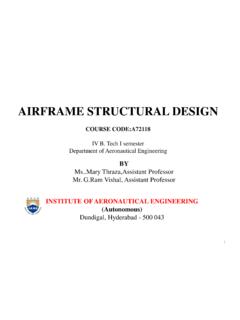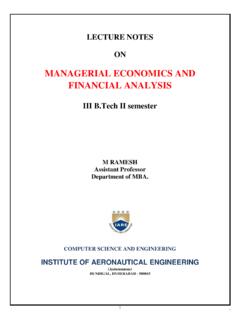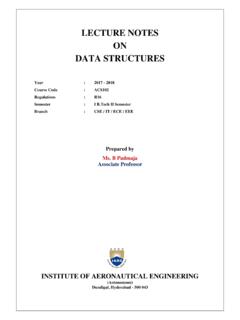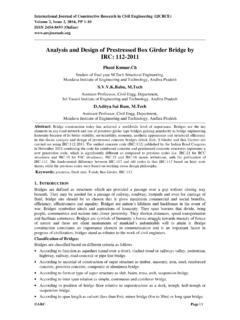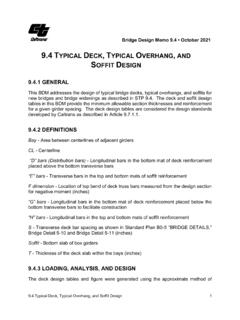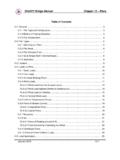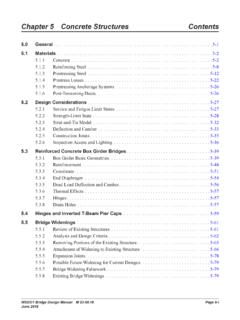Transcription of PRESTRESSED CONCRETE STRUCTURES
1 LECTURE NOTES. ON. PRESTRESSED CONCRETE STRUCTURES . Course code: A80150. Regulation: R15 (JNTUH). IV B. Tech II Sem PREPARED BY. Dr. VENU M Mr GUDE RAMA KRISHNA. Professor Assistant Professor CIVIL ENGINEERING. INSTITUTE OF AERONAUTICAL ENGINEERING. (Autonomous). Dundigal, Hyderabad - 500 043. UNIT-1. INTRODUCTION. Definition of Prestress: Prestress is defined as a method of applying pre-compression to control the stresses resulting due to external loads below the neutral axis of the beam tension developed due to external load which is more than the permissible limits of the plain CONCRETE . The pre-compression applied (may be axial or eccentric) will induce the compressive stress below the neutral axis or as a whole of the beam c/s. Resulting either no tension or compression.
2 Basic Concept PRESTRESSED CONCRETE is basically CONCRETE in which internal stresses of a suitable magnitude and distribution are introduced so that the stresses resulting from the external loads are counteracted to a desired degree. Terminology 1. Tendon:A stretched element used in a CONCRETE member of structure to impart prestress to the CONCRETE . Figure: Tendons 1. 2. Anchorage:A device generally used to enable the tendon to impart and maintain prestress in CONCRETE . Figure: Anchorage 3. Pretensioning: A method of prestressing CONCRETE in which the tendons are tensioned before the CONCRETE is placed. In this method, the CONCRETE is introduced by bond between steel & CONCRETE . 4. Post-tensioning: A method of prestressing CONCRETE by tensioning the tendons against hardened CONCRETE .
3 In this method, the prestress is imparted to CONCRETE by bearing. Materials for prestress CONCRETE members: 1. Cement: The cement used should be any of the following (a) Ordinary Portland cement conforming to IS269. (b) Portland slag cement conforming to IS455. But the slag content should not be more than 50%. (c) Rapid hardening Portland cement conforming to IS8041. 2. (d) High strength ordinary Portland cement conforming to IS8112. 2. CONCRETE : Prestress CONCRETE requires CONCRETE , which has a high compressive strength reasonably early age with comparatively higher tensile strength than ordinary CONCRETE . The CONCRETE for the members shall be air-entrained CONCRETE composed of Portland cement, fine and coarse aggregates, admixtures and water. The air-entraining feature may be obtained by the use of either air-entraining Portland cement or an approved air-entraining admixture.
4 The entrained air content shall be not less than 4 percent or more than 6 percent. 3. Minimum cement content of 300 to 360 kg/m is prescribed for the durability requirement. The water content should be as low as possible. 3. Steel High tensile steel , tendons , strands or cables The steel used in prestress shall be any one of the following:- (a) Plain hard-drawn steel wire conforming to IS1785 (Part-I & Part-III). (b) Cold drawn indented wire conforming to IS6003. (c) High tensile steel wire bar conforming to IS2090. (d) Uncoated stress relived strand conforming to IS6006. High strength steel contains: to carbons, manganese, silica Durability, Fire Resistance & Cover Requirements For Members:- According to IS: 1343-1980. 3. 20 mm cover for pretensioned members 30 mm or size of the cable which ever is bigger for post tensioned members.
5 If the prestress members are exposed to an aggressive environment, these covers are increased by another 10 mm. Necessity of high grade of CONCRETE & steel: Higher the grade of CONCRETE higher the bond strength which is vital in pretensioned CONCRETE , Also higher bearing strength which is vital in post-tensioned CONCRETE . Further creep &. shrinkage losses are minimum with high-grade CONCRETE . Generally minimum M30 grade CONCRETE is used for post-tensioned & M40 grade CONCRETE is used for pretensioned members. The losses in prestress members due to various reasons are generally in the range of 250 N/mm2 to 400 N/mm2. If mild steel or deformed steel is used the residual stresses after losses is either zero or negligible. Hence high tensile steel wires are used which varies from 1600 to 2000 N/mm2.
6 History and development of prestress of PSC: A PRESTRESSED CONCRETE structure is different from a conventional reinforced CONCRETE structure due to the application of an initial load on the structure prior to its use. The initial load or prestress' is applied to enable the structure to counteract the stresses arising during its service period. The prestressing of a structure is not the only instance of prestressing. The concept of prestressing existed before the applications in CONCRETE . Two examples of prestressing before the development of PRESTRESSED CONCRETE are provided. Force-fitting of metal bands on wooden barrels: The metal bands induce a state of initial hoop compression, to counteract the hoop tension caused by filling of liquid in the barrels. 4. The prestressing of a structure is not the only instance of prestressing.
7 The concept of prestressing existed before the applications in CONCRETE . Two examples of prestressing before the development of PRESTRESSED CONCRETE are provided Figure: force fitting of metal bands on wooden barrels Pre-tensioning the spokes in a bicycle wheel The pre-tension of a spoke in a bicycle wheel is applied to such an extent that there will always be a residual tension in the spoke. That tension in spoke will nullify the applied compression. 5. Figure: pre tensioning the spokes in a bicycle wheel For CONCRETE , internal stresses are induced (usually, by means of tensioned steel) for the following reasons. The tensile strength of CONCRETE is only about 8% to 14% of its compressive strength. Cracks tend to develop at early stages of loading in flexural members such as beams and slabs.
8 To prevent such cracks, compressive force can be suitably applied in the perpendicular direction. Prestressing enhances the bending, shear and torsional capacities of the flexural members. In pipes and liquid storage tanks, the hoop tensile stresses can be effectively counteracted by circular prestressing. Forms of Prestressing Steel : Wires:Prestressing wire is a single unit made of steel. Strands: Two, three or seven wires are wound to form a prestressing strand. 6. Figure: strands Tendon: A group of strands or wires are wound to form a prestressing tendon. Cable: A group of tendons form a prestressing cable. Bars: A tendon can be made up of a single steel bar. The diameter of a bar is much larger than that of a wire. Nature of CONCRETE -Steel Interface Bonded tendon: When there is adequate bond between the prestressing tendon and CONCRETE , it is called a bonded tendon.
9 Pre-tensioned and grouted post-tensioned tendons are bonded tendons. Unbonded tendon: When there is no bond between the prestressing tendon and CONCRETE , it is called unbonded tendon. When grout is not applied after post-tensioning, the tendon is an unbonded tendon. Stages of Loading The analysis of PRESTRESSED members can be different for the different stages of loading. The stages of loading are as follows. 1) Initial: It can be subdivided into two stages. a) During tensioning of steel 7. b) At transfer of prestress to CONCRETE . 2) Intermediate: This includes the loads during transportation of the PRESTRESSED members. 3) Final: It can be subdivided into two stages. a) At service, during operation. b) At ultimate, during extreme events. Advantages of Prestressing The prestressing of CONCRETE has several advantages as compared to traditional reinforced CONCRETE (RC) without prestressing.
10 A fully PRESTRESSED CONCRETE member is usually subjected to compression during service life. This rectifies several deficiencies of CONCRETE . The following text broadly mentions the advantages of a PRESTRESSED CONCRETE member with an equivalent RC member. For each effect, the benefits are listed. 1) Section remains uncracked under service loads Reduction of steel corrosion Increase in durability. Full section is utilised Higher moment of inertia (higher stiffness). Less deformations (improved serviceability). Increase in shear capacity. Suitable for use in pressure vessels, liquid retaining STRUCTURES . Improved performance (resilience) under dynamic and fatigue loading. 2) High span-to-depth ratios Larger spans possible with prestressing (bridges, buildings with large column-free spaces).
